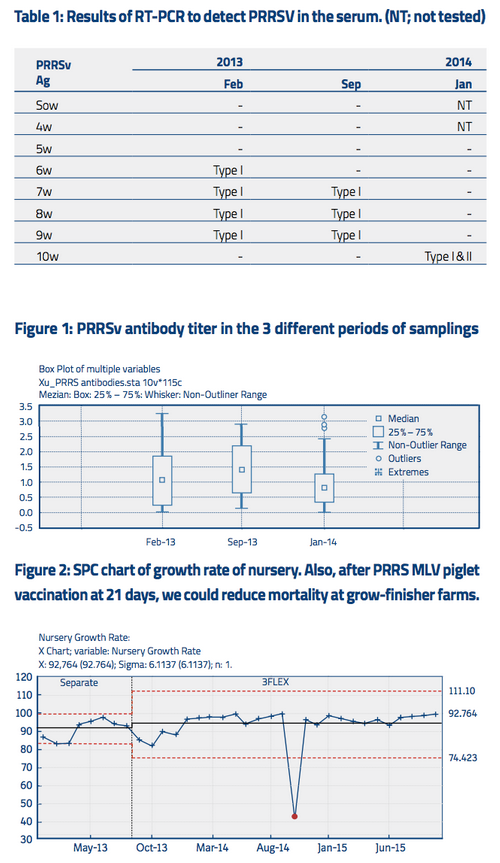



Growing Performance Improvement after Using PRRS MLV at 3weeks Old Piglets in a Korean Swine Farm
Porcine reproductive and respiratory syndrome virus (PRRSV) causes respiratory disease in nursery and grow-finisher pigs and reproductive failure in sows and boars.1PRRSV-infected pigs usually suffer from poor growth performance and are highly susceptible to co- or secondary bacterial and other viral infections2. PRRSV was first isolated in Korea in 1994 and all PRRSV isolates corresponded to the Type II until 2000, Type I PRRSV has recently emerged in Korea3. In this study we evaluate the efficacy of Ingelvac® PRRS MLV (Type II PRRSV based vaccine) piglet vaccination in a Korean swine farm infected with Type I PRRSV.
MATERIALS AND METHODS
This study was conducted in a commercial 750 sow farm with multisite rearing systems which has many different contracted finisher farms. End of 2012, the farm experienced a negative impact in productivity due to infection with TypeIPRRSV. It was decided to initiate a control program using Ingelvac® PRRS MLV. The farm were farm already using FLEXcombo® (Ingelvac CircoFLEX® and Ingelvac MycoFLEX®) in 3 weeks old piglets, therefor it was obvious to use 3FLEX® (Ingelvac CircoFLEX® and Ingelvac MycoFLEX® and Ingelvac® PRRS MLV) at weaning. From Sep 2013 onwards, vaccination was performed with 3FLEX® (2ml) at 3 weeks old piglets. This farm already implemented quarterly mass vaccination in the breeding herd with Ingelvac® PRRS MLV. Strict needle management as one needle for individual sows was implemented. Before/After vaccination, blood samples were taken for antibody examination by ELISA (IDEXX PRRS 3X) and virus detection by RT-PCR. Each 10 blood samples were taken from sows and piglets at the following ages: 4, 5, 6, 7, 8, 9, 10 weeks of age. Performance data was analyzed before and after PRRS MLV piglets vaccination period.
RESULTS
Until Ingelvac® PRRS MLV piglet vaccination was implemented, only TypeIPRRSV was detected in nursery houses (Table 1). Before vaccination, there was seroconversion in early growing pigs. After piglets vaccination, PRRSV was detected only late period of nursery and the variability of SP values was reduced, suggesting a better stabilization process (Table 1, Figure 1). Performance was improved after vaccination (Figure 1). Unfortunately, there was a fire at nursery in Oct 2014. Although there was an accident, the average growth rate was 1.98%, 7.51% higher in vaccinated group (89.66% vs 91.64% vs 97.17%).

DISCUSSION AND CONCLUSION
After the implementation of Ingelvac® PRRS MLV piglet vaccination, PRRS stabilization was achieved and an overall improvement in productivity was observed. This field case provides strong evidence of the ability of Ingelvac® PRRS MLV to control TypeI PRRSV in a Korean farm. Implementation of a 3FLEX vaccination program can be a beneficial method to solve PRRS problems in the nursery. And on top reduce vaccination labor costs
REFERENCES
1. Zimmerman, J., et al. (2006) Diseases of swine. p. 387–417 2. Lunney JK et al. Virus Res. 2010;154:1-6. 3. Kiwon Han., et al. (2011). Clinical and Vaccine Immunology. P. 1600–1607
SW Lee, DH Moon, SY Kang
If you want to read more abstracts like this one visit: https://www.prrs.com/en/publications/abstracts/









